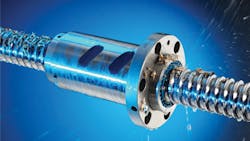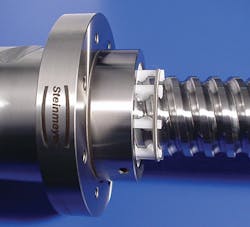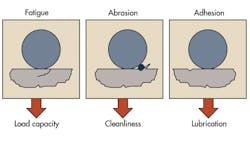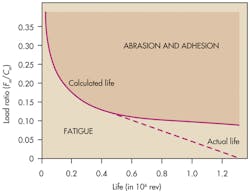Protecting ball screws pays off
Today’s machines tools routinely operate on a 24/7 basis with little, if any, downtime allowed for routine maintenance. They’re also working faster with increased metal-removal capabilities and are more versatile in terms of machining capabilities. But machining faster means higher accelerations and metal-cutting speeds, as well as fast traversing motions. Higher speeds place greater demands on machine tools’ linear drives. At the same time, high-speed cutting and dry-machining hardened and exotic materials generate lots of fine particles, which can accelerate wear on unprotected drives.
Wear in ball screws
Precision-ground ball screws continue to be the preferred drive for machine tools. Their compact design, economical cost, and efficiency are key advantages, especially for high-speed machines. However, the life of a drive screw no longer depends solely on its rated load capacities in relation to the mean applied load. Two other factors must now be considered when designing modern high-speed machines — lubrication and contamination-induced wear.
For steel balls rolling between ground-steel surfaces, there are generally three types of friction. One is direct contact or so-called solid friction if there is no lubricant between them. The other is electrohydrodynamic (EHD) friction, which arises if there is always an oil film between balls and race. And mixed friction means there is some oil film acting as a lubricant but also some direct contact between balls and race.
Compared to other machine components, such as deep-groove or angular-contact ball bearings (or even plain bearings), ball screws exhibit more sliding and twisting. Sliding stems from the lack of retainers holding balls in place. It can be reduced by adding ball chains or plastic spacers to reduce friction between adjacent rolling balls, but both are subject to design limitations. Ball chains, for example, have to fit through ball returns. Twisting is due to the inclined contact lines similar to those found in angular-contact ball bearings. There is also more mixed friction due to lower relative speeds. Ball returns in which balls do not roll uniformly cause additional friction.
Ball screws are usually sized based on the Hertzian pressure of an applied load and the number of load cycles (the classic L10 life equations). The applied load causes material fatigue over time. This is reflected in the equation commonly used to calculate life expectancy:
L10 = (Ca/Fm)3 × 106,
where Fm = mean equivalent load, Ca = dynamic load rating, and L10 = number of hours or revolutions 90% of the bearing will survive.
From this equation, an engineer might conclude that either reducing Fm or increasing the load rating by using a larger unit should increase a bearing’s useful life. This would be a valid conclusion for conventional, slower-turning bearings. Modern machinery moves much faster, a regime where abrasion and adhesion, factors left out of the classic L10 equation, become more important.
Abrasive wear is caused by contamination inside the ball-screw nut. Adhesive wear stems from microwelding — a result of the lubricant-film breakdown. The effect of these wear factors is premature failure from loss of preload. Because advanced servodrives are sensitive to changes in friction, avoiding preload loss becomes critical.
Therefore, to extend the life of ball screws, cleanliness and lubrication to reduce abrasion and adhesion must be considered, as well as dynamic-load capacity.
Lubrication and sealing
Cutting tools can lead extended lives if they are made of ceramic or carry hard coatings. And ball-screw life can be improved with better sealing and lubrication.
It is normally not possible to cover or house ball screws tightly enough to completely keep out contaminants such as dust and finer particles. In many cases, wipers seal nuts from abrasive particles. Regular, noncontacting wipers (labyrinth seals) will not keep out small particles because they inherently have a gap of several tenths of a millimeter between the seal and shaft. Brush wipers are also ineffective in keeping out contaminants.
Lip seals made of elastic materials are substantially better. Like shaft seals, they provide a tight fit. But because these seals typically include a lip that must slide against the screw with considerable pressure to ensure a tight seal, it causes high friction and wear. And in large-pitch ball screws, the lip seals may flex axially, compromising their effectiveness.
Currently, the best solution is segmented plastic wipers with several edges oriented at approximately right angles to the direction of motion. The wipers mount on both ends of the nut and must fit closely because their effectiveness depends largely on their line of contact with the screw. Segments must be stiff enough to remove tough dirt from the screw but remain flexible enough to stay in contact despite the spring preload.
When specifying segmented wipers, ensure that wipers with protruding “fingers” do not contact the elastic end of travel bumpers. In such cases, flush mounted wipers are necessary. Wedge-shaped segments or beveled edges are best when large amounts of dirt are present.
Combining seals and lubrication
Wipers with the added ability to store and distribute lubricant are becoming increasingly popular, especially as environmental regulations on oil disposal become more restrictive. This type of wiper substantially reduces lubricant consumption yet still properly lubricates the ball nuts. Even though the amount of lubricant lost using these wipers is less than that from conventional auto-lubrication devices, regular replenishment of the reservoir is still necessary — and close attention must be paid to cleanliness. As a general rule, when lubricant flow is reduced, sealing must be improved, as the ball nut is no longer flushed with fresh lubricant.
Segmented plastic wipers, combined with felt rings, have proven to be an especially effective combination. The first “stage” in combination wipers can be made from plastics with the mechanical properties to create the right amount of contact with the shaft and guide contaminants away from the screw. The second “stage” is a felt ring that stores lubricant and distributes it as a thin, even film. Felt rings can store up to 75% of their volume in lubricant and are easily refilled.
Another advantage of combination wipers, besides reducing oil consumption, is that they can be used with any liquid lubricant — liquid grease or oil. Liquid grease is especially well suited for applications with short-stroke oscillating moves or low speeds.
As an added bonus, the felt absorbs tiny particles that may get past the plastic wiper, letting it work as a second wiper. This is especially beneficial in applications with fine, abrasive dust or sludge, such as grinding machines. Note, however, that felt cannot be used alone as a wiper, except in relatively clean conditions, as it absorbs coolant and particles. Thus, felt ensures trouble-free operation and enables a 90% reduction in lubricant consumption, but only when used with a good plastic wiper.
Other products on the market combine sealing and lubricant dispensing within a polymer ring. But unlike felt, the polymer needs heat to operate properly — thus adding undesirable friction. The ring, impregnated with oil, forms a seal around the thread, often aided by a spring preload. Friction created by the plastic ring rubbing on the rotating thread warms the ring which lets oil flow out of the polymer. The polymer can reabsorb some of the oil as it passes over the thread, but there is no reservoir to refill. Therefore, these polymer wipers are often used in multiple sets, greatly increasing ball-nut length, to provide enough lubricant. And there is no choice between grease and oil — you must use whatever oil is embedded in the plastic.
Substantial improvement in ball-screw life is possible, even in the most demanding applications, if you provide adequate lubrication and protection from abrasive contamination. A combination wiper that can store and replenish lubricant, together with an effective finger type seal, also improves ball-screw reliability. The cost for this option is minor compared to the downtime from unexpected and premature failures. And, in some cases, long-term lubrication or even “for-life” lubrication may be feasible if the proper lubricant is selected.
Resources: Steinmeyer
Edited by Stephen J. Mraz





